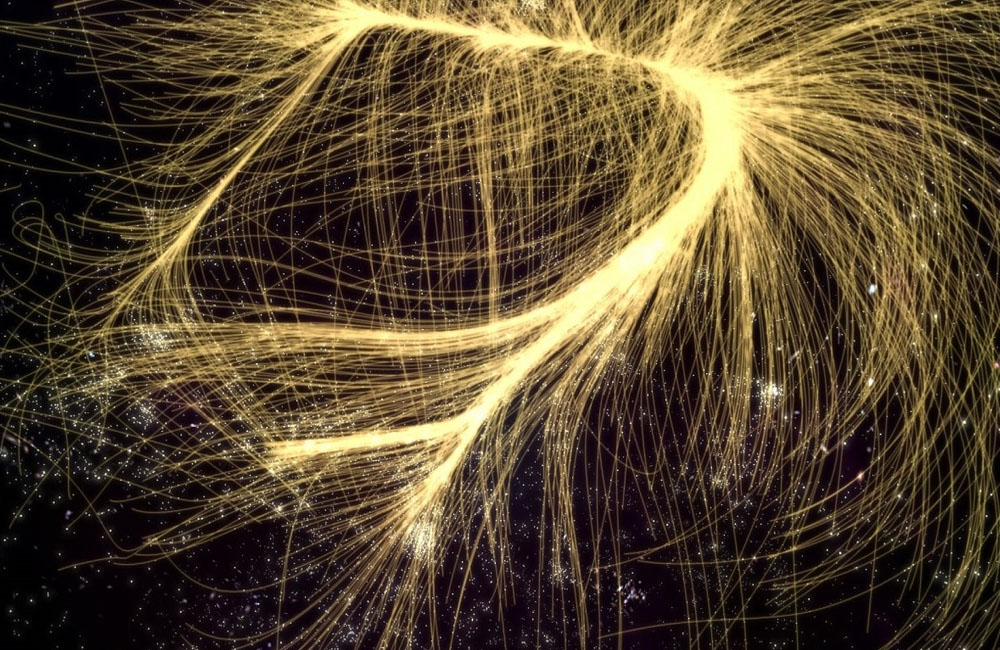The cosmic web is the vast, intricate structure of the universe on its largest scales, consisting of galaxies, galaxy clusters, and dark matter connected by filaments, separated by immense voids. It resembles a gigantic web of matter, stretching across hundreds of millions of light-years.
1. Discovery and Formation of the Cosmic Web
(A) Discovery and Observations
- The concept of a web-like cosmic structure emerged in the 1980s and 1990s from galaxy surveys such as:
- CfA (Center for Astrophysics) Galaxy Survey (1989)
- Sloan Digital Sky Survey (SDSS)
- 2dF Galaxy Redshift Survey
- These surveys revealed that galaxies are not randomly distributed but form filaments, clusters, and vast empty voids, resembling a cosmic web.
(B) Formation: Role of Dark Matter and Gravity
- The cosmic web formed through gravitational instability after the Big Bang (~13.8 billion years ago).
- Dark matter provided the initial gravitational framework, pulling normal matter (baryons) into web-like structures.
- Over billions of years, matter condensed along these filaments, forming galaxies and galaxy clusters.
2. Structure of the Cosmic Web
The cosmic web is composed of four main components:
(A) Filaments (The Cosmic Highways)
- The long, thread-like structures that connect galaxies and clusters.
- Composed of dark matter, gas, and galaxies.
- Span hundreds of millions of light-years but are thin (~10–20 million light-years wide).
- Most of the universe’s ordinary matter (baryonic matter) is in filaments, including the missing baryons problem solution.
(B) Nodes (Galaxy Clusters and Superclusters)
- Dense regions where multiple filaments intersect.
- Contain large clusters of galaxies and supermassive black holes.
- Example: The Virgo Supercluster, home to the Milky Way.
(C) Voids (Cosmic Empty Spaces)
- Enormous, nearly empty regions spanning hundreds of millions of light-years.
- Contain very few galaxies, with densities much lower than filaments.
- Example: The Boötes Void, one of the largest known voids, ~330 million light-years across.
(D) Walls (Sheets of Galaxies)
- Large, sheet-like arrangements of galaxies forming boundaries between voids.
- Example: The Sloan Great Wall, a massive cosmic structure spanning 1.4 billion light-years.
3. Role of Dark Matter in the Cosmic Web
- Dark matter (85% of the universe’s mass) acts as the invisible backbone of the cosmic web.
- It forms gravitational wells that pull in normal matter, shaping the web.
- Simulations like the Millennium Run and Illustris Project show how dark matter structures influence galaxy formation.
4. Observing the Cosmic Web
(A) Galaxy Surveys
- Large-scale galaxy surveys like SDSS map millions of galaxies, revealing web-like structures.
(B) Lyman-Alpha Emission (Tracing Gas Filaments)
- In 2014, astronomers observed cosmic web filaments by detecting Lyman-alpha emissions from intergalactic hydrogen.
(C) Gravitational Lensing
- Light from distant galaxies bends around dark matter filaments, helping scientists map the cosmic web indirectly.
5. Importance of the Cosmic Web
- Explains Galaxy Distribution: Why galaxies are clustered instead of evenly spread.
- Tests Cosmological Models: Confirms Lambda Cold Dark Matter (ΛCDM) as the leading model.
- Reveals Missing Baryons: Most of the universe’s normal matter exists in the filaments.
- Affects Cosmic Evolution: Filaments feed galaxies with gas, influencing star formation.
6. Future Research and Exploration
- Next-Generation Surveys: Euclid Space Telescope and Vera C. Rubin Observatory aim to provide even more detailed maps of the cosmic web.
- Dark Matter and Energy Studies: Investigating how dark matter shapes the web and the role of dark energy in its evolution.
- Simulations and AI: Advanced cosmological simulations (like IllustrisTNG) and machine learning will refine our understanding of the cosmic web.
7. Conclusion
The cosmic web is the largest known structure in the universe, shaping the distribution of galaxies and the evolution of cosmic structures. Its study bridges cosmology, dark matter physics, and galaxy formation, providing a deeper understanding of the universe’s origins and fate.







